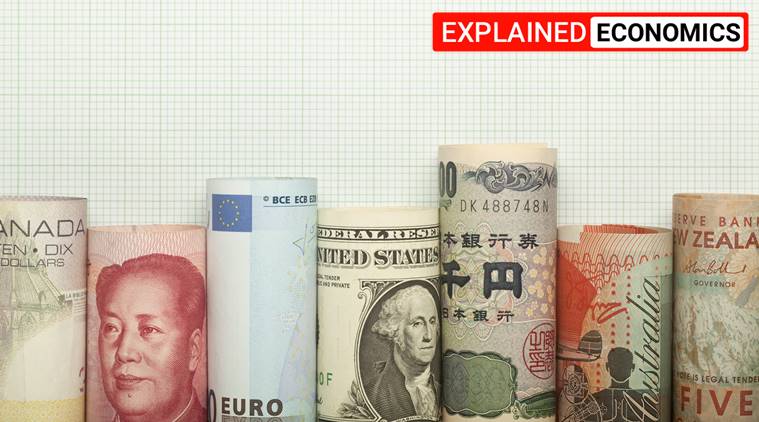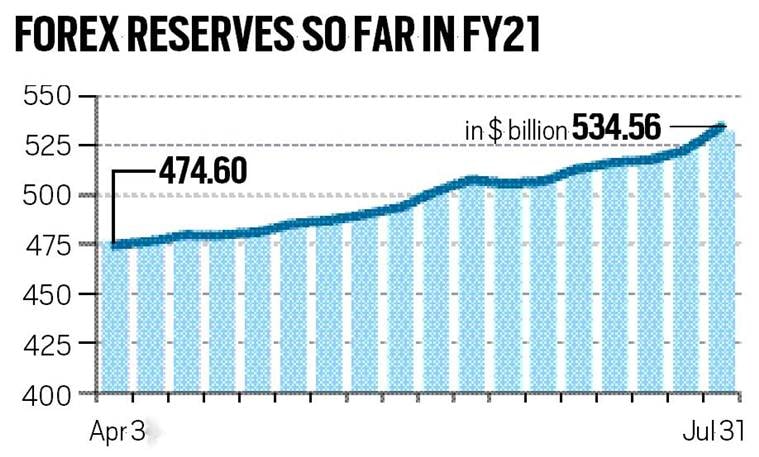
[ad_1]
, Sandeep Singh
, Edited by Explained Desk | Mumbai, New Delhi |
Updated: August 8, 2020 1:11:14 pm
 In ten months, India has added 25 per cent of the reserves it had till September 20, 2019. (Getty Images/File)
In ten months, India has added 25 per cent of the reserves it had till September 20, 2019. (Getty Images/File)
Covid-hit India’s foreign exchange reserves jumped by a record $11.9 billion in the week ending July 31 to hit a fresh high of $534.5 billion, making it the fifth largest holder of reserves in the world. During the 10-month period between September 27, 2019 and July 31, 2020, the foreign exchange reserves have swelled by $100 billion.
At a time when the economy is under stress and the growth is expected to contract in 2020-21, the rising forex reserves have come as a breather as it can cover India’s import bill of more than one year.
India’s foreign exchange reserves: How has the rise been?
The trend of rising foreign exchange reserves started after Finance Minister Nirmala Sitharaman announced a sharp cut in corporate tax rates on September 20, 2019. While investor sentiments turned weak after the budget announcement in July to impose higher surcharge, the government’s decision to reverse its budget decision relating to higher surcharge impact on FPIs along with a cut in the corporate tax rate in September played a significant role in turning the investors mood and draw them to invest in the Indian economy and markets.
Between September 20, 2019 and July 31, 2020, the reserves have grown by $106 billion and, since the beginning of April, it has grown by $60 billion. So, in ten months India has added 25 per cent of the reserves it had till September 20, 2019. India is now fifth in global ranking behind China ($ 3,298 billion), Japan ($ 1,383 billion), Switzerland ($ 896 billion) and Russia ($ 591 billion).
What has led to this rise in forex reserves?
The rise has been in several stages and has been led by different factors over the last ten months. Experts say that the rise in foreign exchange inflows through Foreign portfolio investment (FPI) and Foreign Direct Investment (FDI and has also been supported by decline in import bill over the last 4-5 months on account of dip in crude prices and trade impact following Covid-19 pandemic.
 Forex reserves so far in FY21
Forex reserves so far in FY21
Also read | The importance of India’s rising forex reserves amid Covid economic crisis
Some of the key factors include:
FPI inflows: While it started with a sharp rise in FPI inflows following the government’s decision in September to cut corporate tax rate. Between April and December 2019, FPIs pumped in a net $15.1 billion, according to the RBI.
Dip in crude oil prices: India’s oil import bill declined as the global spread of coronavirus since February 2020 not only roiled the stock markets but also led to a crash in the Brent crude oil prices. While crude accounts for almost 20 per cent of India’s total import bill, Brent crude oil prices fell to levels of $20 per barrel towards March end, it dropped further and traded between $9 and $20 in April. In January 2020, Brent crude was trading between $60 and $70 per barrel.
Import savings: Lockdown across countries in response to Covid-19 pandemic impacted global trade and has resulted in a sharp dip in import expenditure — electronics, gold and also crude oil prices among others.
FDI inflows: Between September 2019 and March 2020 foreign direct investments stood at $23.88 billion and in April and May it amounted to $5.9 billion. Market experts say that a lot of FDI has also come in June and July too, especially the Rs 1 lakh crore plus investment by global tech giants in Jio Platforms. Thus FDI inflow has been a significant contributor to the rise in foreign exchange reserves.
Dip in gold imports: Gold which was a big import component for India witnessed a sharp decline in the quarter ended June 2020 following the high prices and the lockdown induced by the Covid-19 pandemic. According to the World Gold Council (WGC), gold imports plummeted by 95 per cent to 11.6 tonnes in the quarter as compared to 247.4 tonnes in the same period a year ago due to logistical issues and poor demand. The value of gold transacted during the June quarter fell to Rs 26,600 crore, down by 57 per cent as compared to Rs 62,420 crore a year ago, WGC said.
📣 Express Explained is now on Telegram. Click here to join our channel (@ieexplained) and stay updated with the latest
What does the rising forex reserves mean?
The rising forex reserves give a lot of comfort to the government and the Reserve Bank of India in managing India’s external and internal financial issues at a time when the economic growth is set to contract by 5.8 per cent in 2020-21. It’s a big cushion in the event of any crisis on the economic front and enough to cover the import bill of the country for a year. The rising reserves have also helped the rupee to strengthen against the dollar. The foreign exchange reserves to GDP ratio is around 15 per cent. Reserves will provide a level of confidence to markets that a country can meet its external obligations, demonstrate the backing of domestic currency by external assets, assist the government in meeting its foreign exchange needs and external debt obligations and maintain a reserve for national disasters or emergencies. “Adequate forex reserves should provide room for the RBI to cut rates and support recovery. We estimate that the RBI can sell $50 bn to defend the rupee in case of a speculative attack. Of note, RBI action to support growth should attract FPI equity flows,” says a Bank of America report.
What does the RBI do with the forex reserves?
The Reserve Bank functions as the custodian and manager of forex reserves, and operates within the overall policy framework agreed upon with the government. The RBI allocates the dollars for specific purposes. For example, under the Liberalised Remittances Scheme, individuals are allowed to remit up to $250,000 every year. The RBI uses its forex kitty for the orderly movement of the rupee. It sells the dollar when the rupee weakens and buys the dollar when the rupee strengthens. Of late, the RBI has been buying dollars from the market to shore up the forex reserves. When the RBI mops up dollars, it releases an equal amount in the rupees. This excess liquidity is sterilised through issue of bonds and securities and LAF operations to prevent a rise in inflation.
Are forex reserves giving returns to India?
Only gold reserves have given big returns to India. While the RBI has not disclosed the actual returns from forex reserves, experts estimate India is likely to get only negligible returns as interest rates in the US and Eurozone are around one per cent. On the contrary, India could be facing a cost to keep the reserves abroad. Out of the total foreign currency assets, as much as 59.7 per cent was invested in securities abroad, 33.37 per cent was deposited with other central banks of other countries and the BIS and the balance 7.06 per cent comprised deposits with commercial banks overseas as of March 2020. Further, as at end-March, 2020, the RBI held 653.01 tonnes of gold, with 360.71 tonnes being held overseas in safe custody with the Bank of England and the Bank for International Settlements, while the remaining gold is held domestically. With gold prices shooting up around 40 per cent to over Rs 55,000 per 10 grams this year, the value of gold holdings has shot up.
Also in Explained | Kerala Air India Express plane crash: Why the tabletop runway is a challenge
📣 The Indian Express is now on Telegram. Click here to join our channel (@indianexpress) and stay updated with the latest headlines
For all the latest Explained News, download Indian Express App.
© The Indian Express (P) Ltd
[ad_2]
Source link